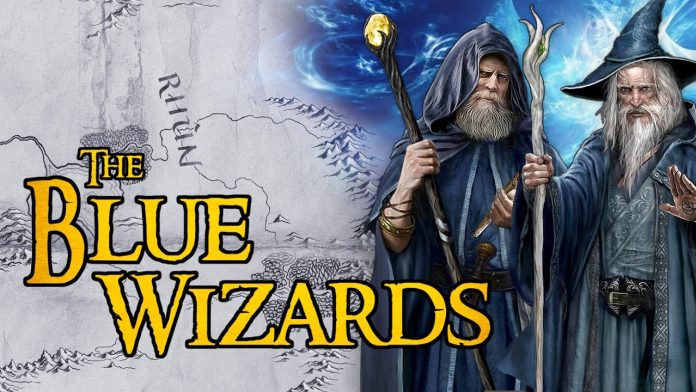The Hidden Mission of the East and the Forgotten Hope of Middle-earth
They came without fanfare. No fireworks, no hobbit tales, no councils of Elrond. Just silence, blue robes, and a road that led eastward—away from everything we know.
While Gandalf battled a Balrog, and Saruman fell to pride, two of their order disappeared into the margins of the map. Their names? Alatar and Pallando. Their purpose? For a long time, even Tolkien himself wasn’t sure.
Yet buried in his letters and final writings lies a revelation: the Blue Wizards may have played a far greater role in the salvation of Middle-earth than anyone ever knew.
The Istari: Spirits in Mortal Form
The Blue Wizards were among the five Istari, or “Wise Ones,” sent by the Valar in the Third Age to help guide the Free Peoples of Middle-earth against the rising shadow of Sauron. As Tolkien explains in Unfinished Tales, these beings were actually Maiar, angelic spirits from the Undying Lands, given old man’s bodies and forbidden to use their full divine power:
“For with the consent of Eru they sent members of their own high order, but clad in bodies as of Men, real and not feigned… and they could suffer pain and weariness, and even be slain; though they were not subject to disease and old age would not touch them.” (Unfinished Tales, “The Istari”)
We know three of them well: Gandalf the Grey, Saruman the White, and Radagast the Brown. But Alatar and Pallando—clad in blue—are barely mentioned in The Lord of the Rings. They seem to vanish from the narrative entirely.
In early writings, Tolkien left their fate vague, even pessimistic.
“I suspect they failed, as Saruman did, though doubtless in different ways.” (Letter #156)
But in later reflections, he revised their story dramatically.
A New Vision: The Hope of the East
In The Peoples of Middle-earth, one of Tolkien’s final and most revealing writings, he describes a different fate for the Blue Wizards. He imagines they arrived much earlier than the others—perhaps in the Second Age, not the Third.
Their names were not just Alatar and Pallando, but Morinehtar (Darkness-slayer) and Rómestámo (East-helper). And their purpose was crucial:
“They must have had very great influence on the history of the Second Age and Third Age in weakening and disarraying the forces of the East… who would both in the Second Age and Third Age otherwise have… outnumbered the West.” (The Peoples of Middle-earth, “Last Writings”)
If this version is canon, the Blue Wizards didn’t just disappear. They undermined Sauron’s power at the source. They planted resistance in the lands beyond Mordor, among peoples long under Sauron’s sway.
Their role was not to lead armies or council kings—but to kindle light in forgotten lands.
East of East: What Did They Do?
Tolkien never detailed the exact deeds of the Blue Wizards. That silence invites speculation, but also reveals something essential about them.
They were sent to the East. Not to Gondor, Rohan, or the Shire, but to the vast, unknown lands that lie beyond Mordor—regions like Rhûn and Khand. These are places we never see in Tolkien’s narrative, but which were crucial to Sauron’s power.
The Blue Wizards, Tolkien wrote, may have founded secret orders, inspired quiet revolts, and helped prevent Sauron from commanding the sheer numbers that would have overwhelmed the West.
“They were founders or beginners of secret cults and ‘magic’ traditions that outlasted the fall of Sauron.” (The Peoples of Middle-earth)
In some versions, this is framed negatively, as failure. In others, it is their very secrecy that makes their mission so powerful.
After all, the greatest danger wasn’t just Sauron. It was the idea that evil had already won in the forgotten corners of the world. The Blue Wizards resisted that despair with small acts of hope.
Not All Heroes Are Seen
Tolkien often exalted the “quiet hero” — Sam over Boromir, Frodo over Isildur. The Blue Wizards fit this archetype perfectly.
They are unsung saints of Middle-earth: beings who gave up the West, glory, and even memory, to stand alone in the dark. Their success is not measured in victories, but in what never happened: armies that were never raised, conquests that were never completed.
And that is perhaps their greatest legacy.
They remind us that victory often comes not through battle cries, but through unseen resistance, far from the light of legend.
Final Thoughts: Why the Blue Wizards Still Matter
Tolkien never wrote a novel about Alatar and Pallando. But their presence, however faint, adds texture and mystery to Middle-earth.
Their story raises deeper questions:
- Can good thrive even where no one is watching?
- Is anonymity a form of heroism?
- How much evil was undone by quiet faith we never saw?
Their tale is not finished. In a sense, it never can be.
But perhaps that’s the point.
In a world obsessed with spotlight, the Blue Wizards remind us:
the most important work is often done where no one will ever know.
Sources:
- Tolkien, J.R.R. Unfinished Tales (1980)
- Tolkien, J.R.R. The Peoples of Middle-earth (1996)
- Tolkien, J.R.R. The Letters of J.R.R. Tolkien, edited by Humphrey Carpenter (1981)
- Hammond, Wayne G., and Christina Scull. The J.R.R. Tolkien Companion and Guide (2006)







